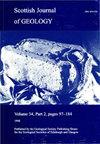苏格兰-加拿大碰撞中应变分配和岩浆作用的时间,来自高Ba-Sr奥克尼花岗岩杂岩的证据
IF 0.5
4区 地球科学
Q4 GEOLOGY
引用次数: 4
摘要
奥克尼花岗岩复合体主宰着苏格兰奥克尼露出地面的地下室。它包括灰色和粉红色的可变叶理花岗岩,以及结构较年轻的伟晶岩和细晶岩。根据地球化学特征,将这些花岗岩归属于苏格兰高Ba–Sr花岗岩。花岗岩受同岩浆伸展东西走向糜棱岩带的变形。它们被类似定向的伸展层状岩局部叠加,在一种情况下,被类似定向伸展断层叠加。灰色和粉红色花岗岩的锆石U–Pb CA-ID-TIMS测年为431.93 ± 0.46和430.26 ± 0.92 马。一种细晶岩切割糜棱岩花岗岩,并被层状岩切割,其年代为428.50年 ± 0.31 马。我们对剪切带进行了解释,以记录花岗岩侵位和冷却期间的南北延伸,可能位于浅地壳深度(4-12 km)。延伸最好用与Great Glen断层上的位移相关的辅助拉开结构来解释。在这种情况下,奥克尼花岗岩复合体的年代为432–429 马,与431-429同时代 Ma Moine推力。这表明,整个苏格兰高地的应变分配和高Ba–Sr岩浆作用是对斯堪的纳维亚碰撞期间Laurentia下方Avalonia俯冲尝试的直接反应。补充材料:地质年代和地球化学数据(表1和表2)电子表格可在https://doi.org/10.6084/m9.figshare.c.4304387本文章由计算机程序翻译,如有差异,请以英文原文为准。
Timing of strain partitioning and magmatism in the Scottish Scandian collision, evidence from the high Ba–Sr Orkney granite complex
The Orkney granite complex dominates the outcropping basement on Orkney, Scotland. It comprises a grey and a pink variably foliated granite, and structurally younger pegmatites and aplites. Based on geochemical characteristics the granites are assigned to the Scottish high Ba–Sr granites. The granites are deformed by synmagmatic extensional east–west-trending mylonite zones. These are locally overprinted by similarly oriented extensional phyllonites and, in one case, by similarly oriented extensional faults. The grey and the pink granites are dated by zircon U–Pb CA-ID-TIMS to 431.93 ± 0.46 and 430.26 ± 0.92 Ma, respectively. An aplite cutting mylonitic granite and cut by phyllonite is dated to 428.50 ± 0.31 Ma. We interpret the shear zones to record north–south extension during emplacement and cooling of the granites, likely at a shallow crustal depth (4–12 km). The extension is best explained by a subsidiary pull-apart structure related to displacement on the Great Glen Fault. In this case, the Orkney granite complex dates transcurrent faulting to 432–429 Ma, coeval with the 431–429 Ma Moine Thrust. This indicates that strain partitioning and high Ba–Sr magmatism across the Scottish Highlands was an immediate response to attempted subduction of Avalonia beneath Laurentia during the Scandian collision. Supplementary material: Geochronological and geochemical data (Tables 1 and 2) as spreadsheets are available at https://doi.org/10.6084/m9.figshare.c.4304387
求助全文
通过发布文献求助,成功后即可免费获取论文全文。
去求助
来源期刊

Scottish Journal of Geology
地学-地质学
CiteScore
1.70
自引率
0.00%
发文量
10
审稿时长
>12 weeks
期刊介绍:
Although published only since 1965, the Scottish Journal of Geology has a long pedigree. It is the joint publication of the Geological Society of Glasgow and the Edinburgh Geological Society, which prior to 1965 published separate Transactions: from 1860 in the case of Glasgow and 1863 for Edinburgh.
Traditionally, the Journal has acted as the focus for papers on all aspects of Scottish geology and its contiguous areas, including the surrounding seas. The publication policy has always been outward looking, with the Editors encouraging review papers and papers on broader aspects of the Earth sciences that cannot be discussed solely in terms of Scottish geology.
The diverse geology of Scotland continues to provide an important natural laboratory for the study of earth sciences; many seminal studies in geology have been carried out on Scottish rocks, and over the years the results of much of this work had been published in the Journal and its predecessors.
The Journal fully deserves its high reputation worldwide and intends to maintain its status in the front rank of publications in the Earth sciences.
 求助内容:
求助内容: 应助结果提醒方式:
应助结果提醒方式:


